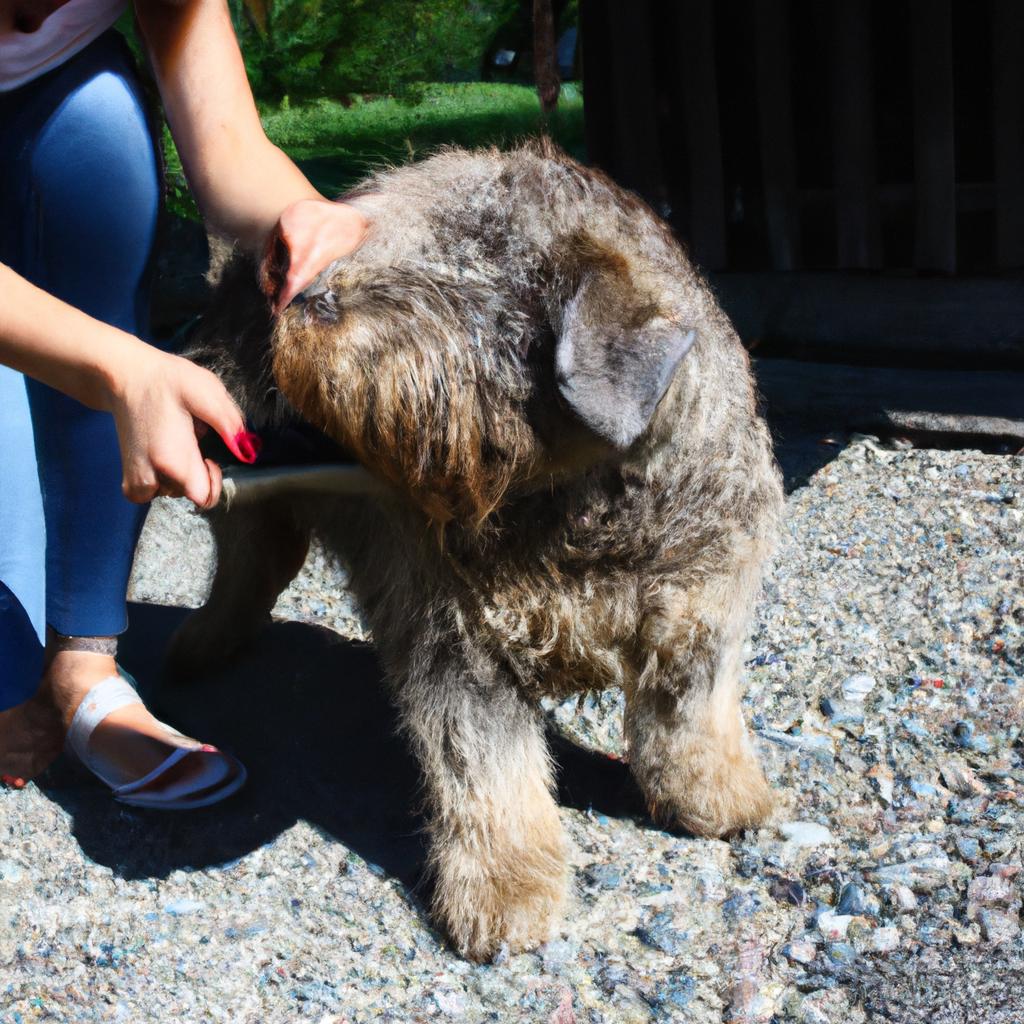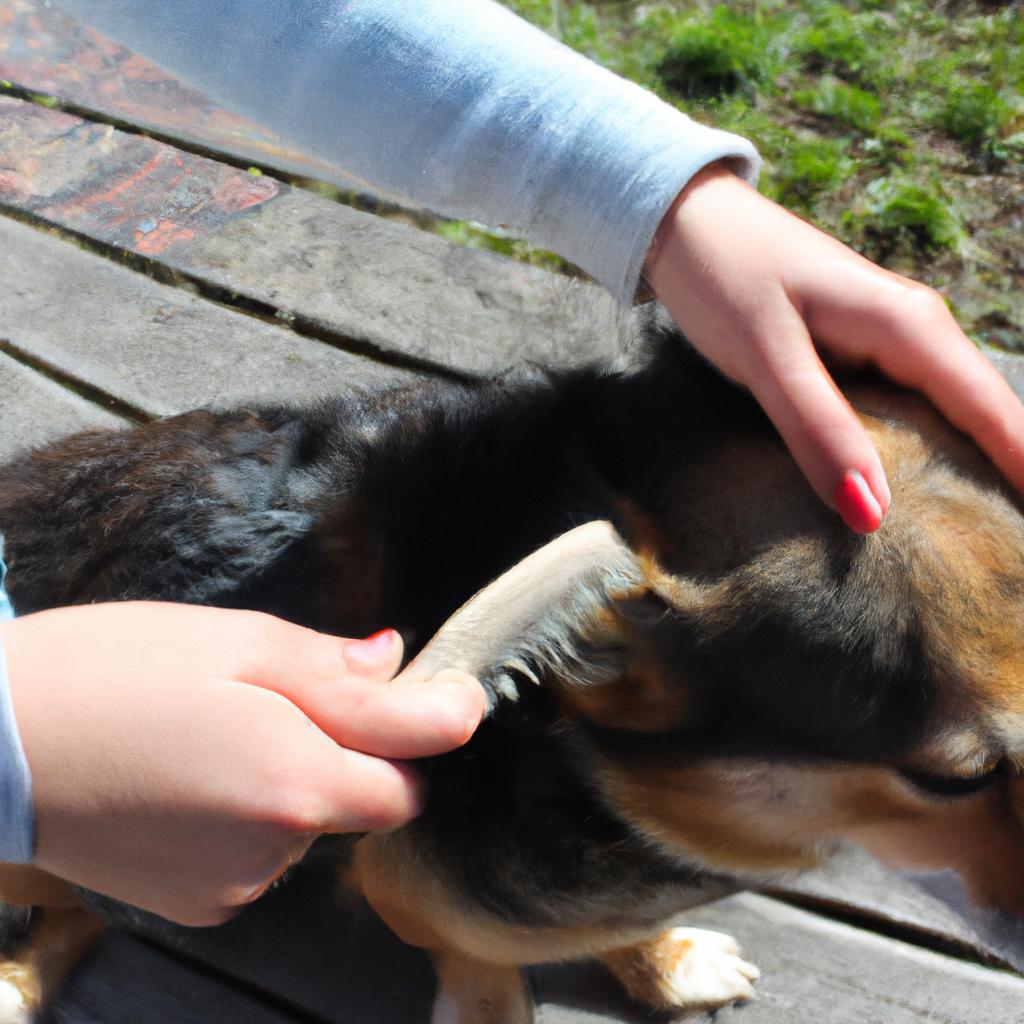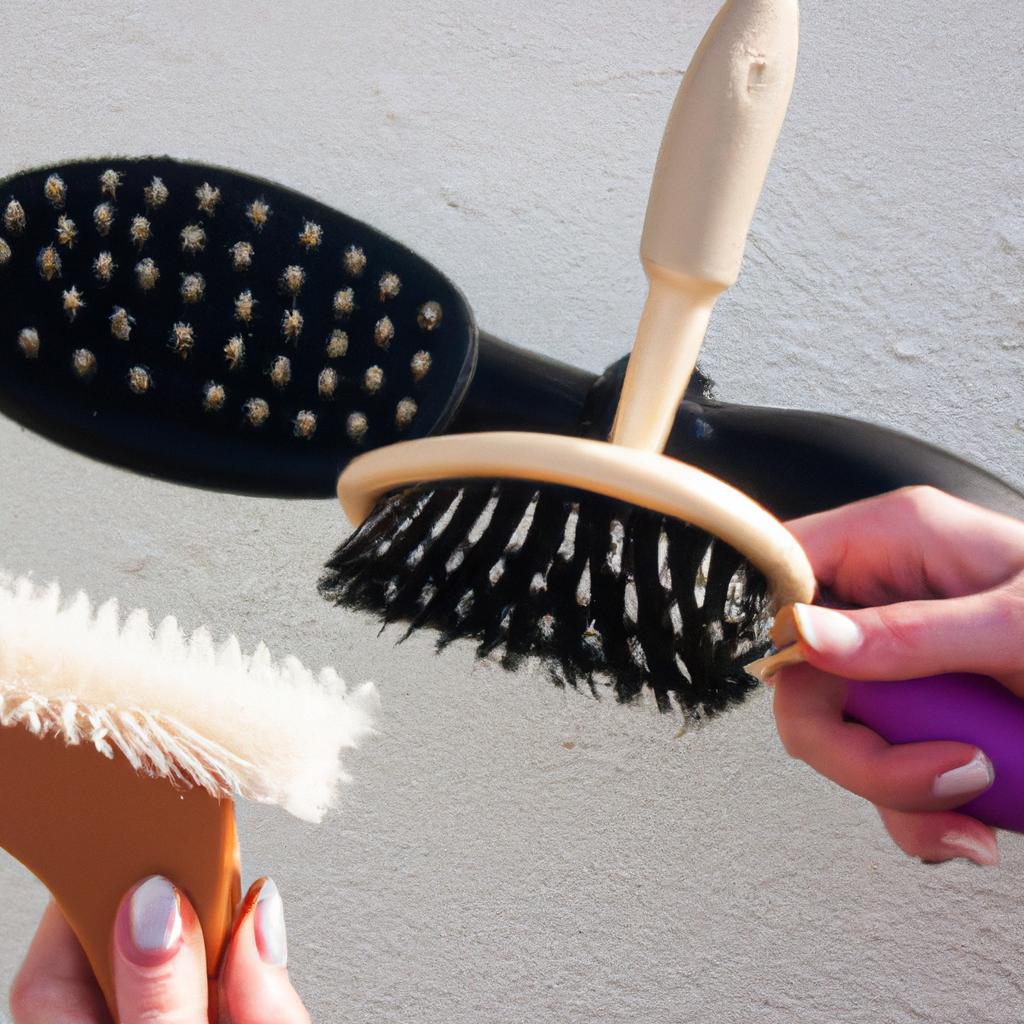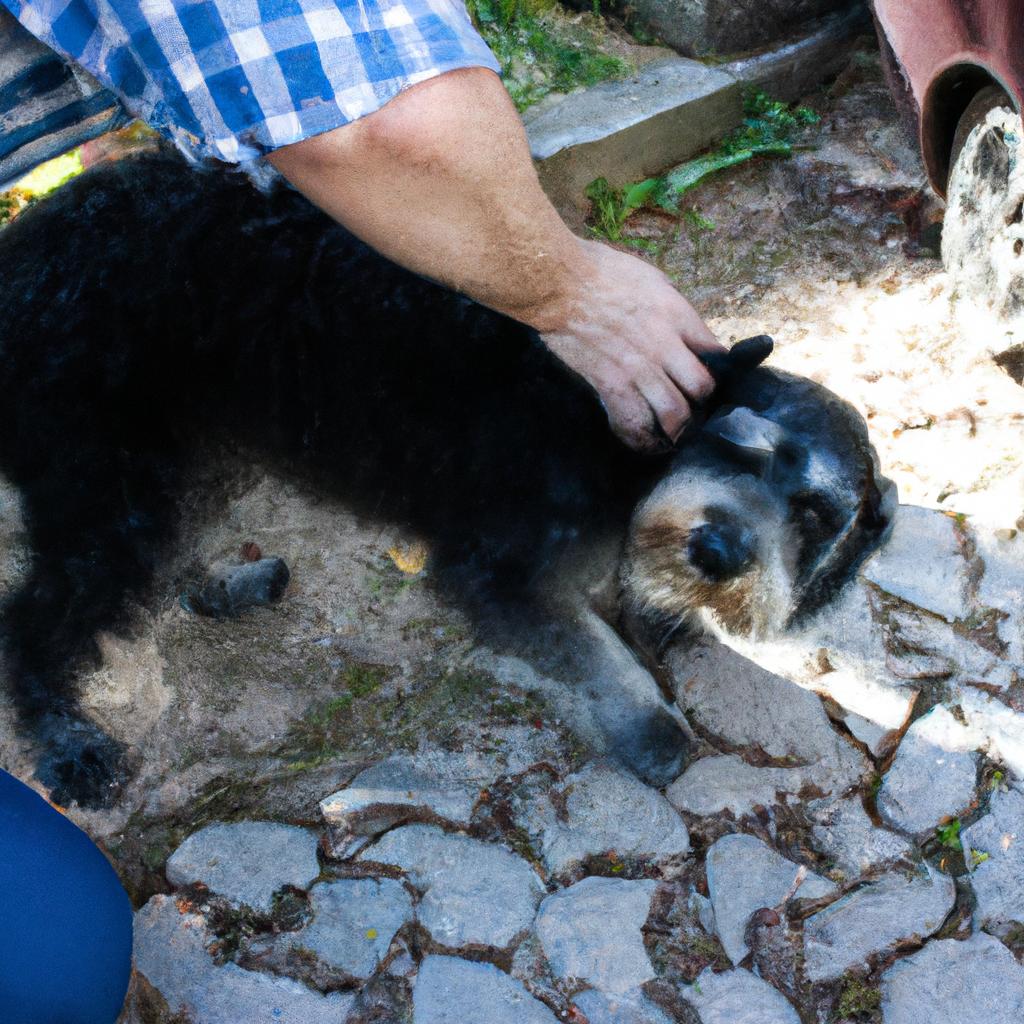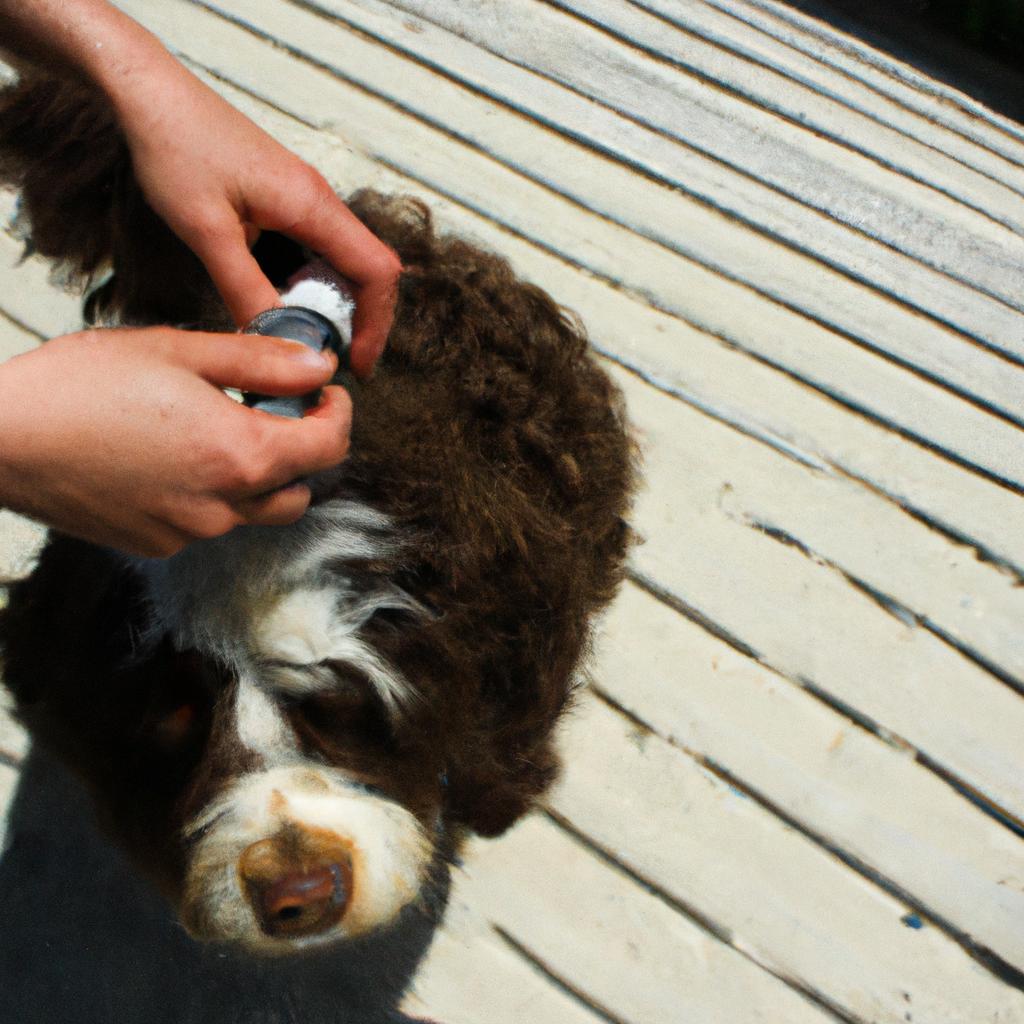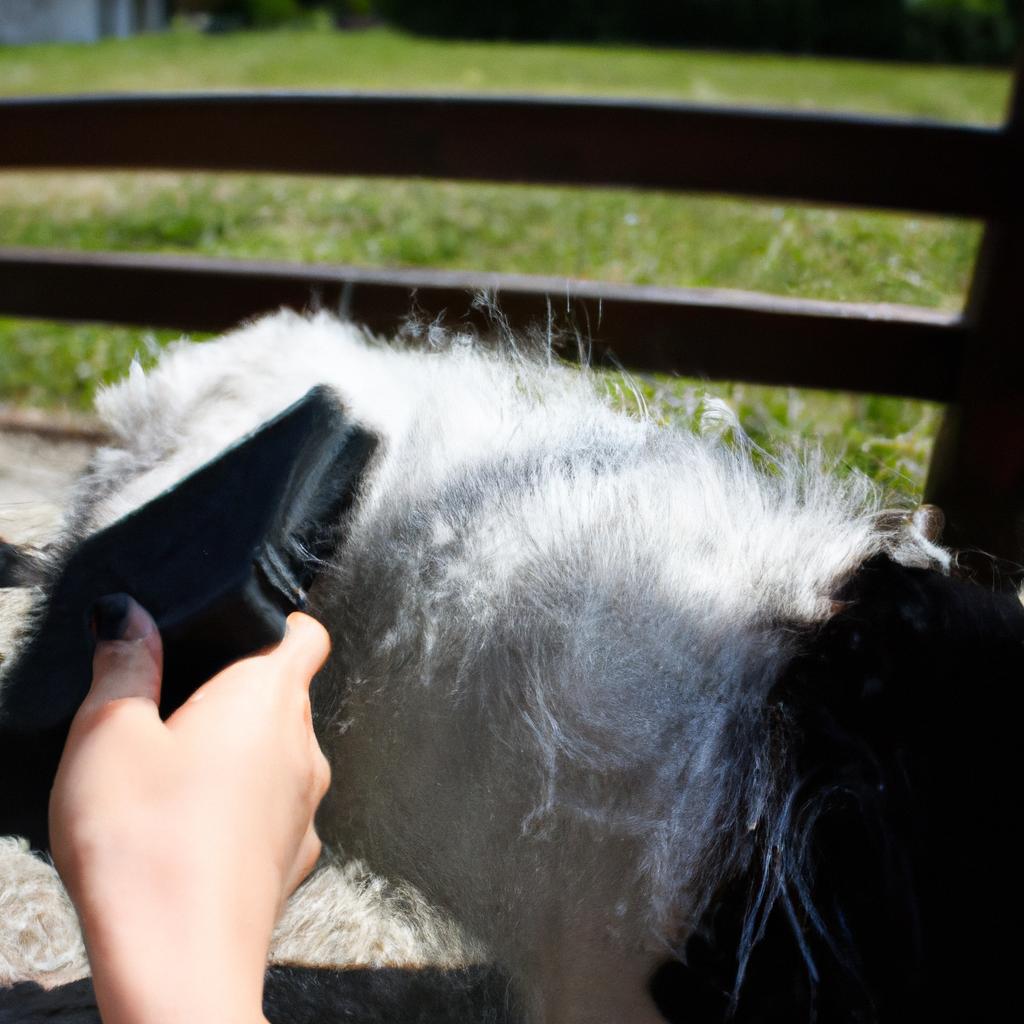Coat Brushing: Essential Technique for Dog Grooming Salon
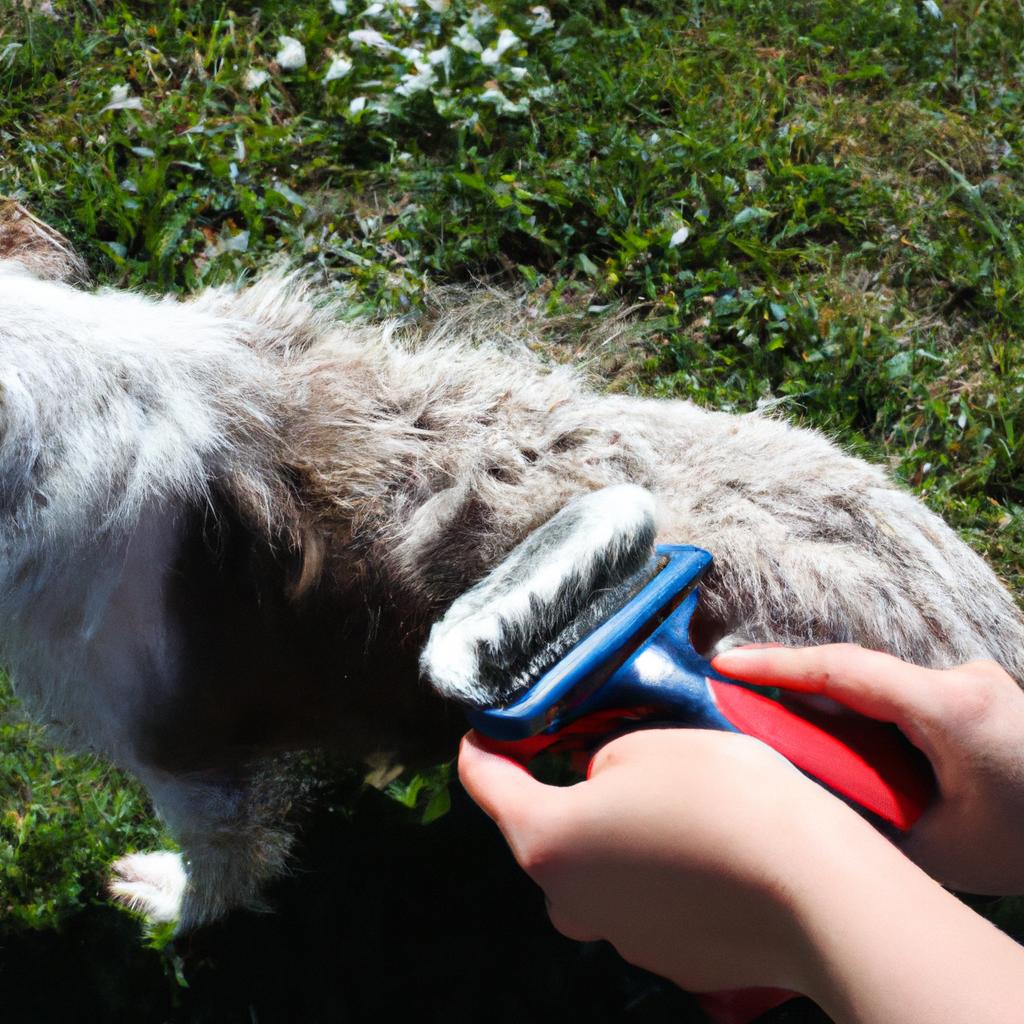
Coat brushing is an essential technique for dog grooming salons, ensuring the health and appearance of our beloved canine companions. The act of brushing a dog’s coat involves removing tangles, mats, and loose hair from their fur, while also promoting blood circulation in the skin and distributing natural oils throughout the coat. This article aims to explore the importance of coat brushing in maintaining a dog’s overall well-being, discussing its benefits and techniques that can be employed by professional groomers.
To demonstrate the significance of proper coat brushing, let us consider a hypothetical case study. Imagine a Golden Retriever named Max who visits his local grooming salon on a regular basis. Over time, due to negligence or lack of knowledge about coat maintenance, Max’s once luscious mane becomes tangled and matted. These knots not only cause discomfort but also hinder air circulation to his skin, potentially leading to skin irritations or infections. However, with consistent and attentive brushing sessions at the grooming salon, Max’s tangled coat is gradually restored to its former glory – silky smooth and free from any bothersome matting.
In this article, we will delve into various aspects surrounding coat brushing that contribute to its indispensability within the realm of professional dog grooming. By understanding these factors and implementing the appropriate brushing techniques, groomers can ensure that dogs like Max receive the care they need and deserve.
First and foremost, regular coat brushing helps prevent matting and tangling of a dog’s fur. Mats are clumps of tangled hair that form when loose hairs interweave and become compacted. Not only do mats make a dog’s coat appear disheveled, but they can also cause discomfort by pulling on the skin. By brushing regularly, groomers can identify and address any tangles or mats before they become more severe.
Furthermore, coat brushing promotes healthy skin by stimulating blood circulation. When groomers brush a dog’s coat, they are not only removing loose hair but also gently massaging the skin underneath. This massage action increases blood flow to the area, which in turn promotes healthier skin cells and overall well-being for the dog.
Additionally, brushing helps distribute natural oils throughout a dog’s coat. These oils serve as a protective barrier for their skin and hair, keeping them moisturized and preventing dryness or irritation. Regular brushing ensures that these oils are evenly distributed from root to tip, maintaining a healthy shine and texture in the dog’s fur.
Proper technique is crucial when it comes to coat brushing. Groomers should use brushes or combs specifically designed for different types of coats (e.g., slicker brushes for long-haired breeds). They should start by using wider-toothed tools to remove any loose debris or knots gently. Then, with narrower-toothed tools or grooming rakes, groomers can work through smaller sections of the coat more thoroughly.
It is important to note that some dogs may have specific needs when it comes to coat brushing. Breeds with double coats (e.g., Siberian Huskies) may require extra attention during shedding seasons to remove excess undercoat effectively. Dogs with curly or wiry hair (e.g., Poodles) may benefit from regular brushing to prevent matting and maintain their signature textured look.
In conclusion, coat brushing plays a vital role in the overall health and appearance of our furry friends. By removing tangles, promoting blood circulation, and distributing natural oils, groomers can ensure that dogs’ coats remain vibrant and free from discomfort. Understanding the importance of proper brushing techniques allows professionals to provide the best care possible for their canine clients like Max. So, remember to brush regularly and keep those coats looking fabulous!
Scissor Grooming
Imagine a scenario where a dog with long, unruly fur enters a grooming salon. The groomer assesses the situation and decides to use scissor grooming techniques to give the dog a neat and tidy appearance. Scissor grooming is an essential skill for professional groomers as it allows them to carefully trim and shape a dog’s coat according to specific breed standards or owner preferences.
To begin with, scissor grooming requires precision and attention to detail. Groomers must have sharp scissors that are suitable for different types of coats, such as straight or curved blades. This ensures clean cuts without causing discomfort or injury to the dog. Additionally, they need to be skilled in identifying various coat textures and lengths, enabling them to choose appropriate scissor techniques accordingly.
The techniques used in scissor grooming can vary depending on the desired outcome. For instance, thinning shears are often employed for blending uneven areas of fur or creating natural-looking transitions between longer and shorter sections. Point cutting involves using scissors at an angle to create texture or layers within the coat. On the other hand, sculpting involves shaping the fur into specific styles by removing excess hair strategically.
Understanding how scissor grooming fits into the overall process of dog grooming is crucial. While some dogs may require only minimal trimming, others may benefit from more extensive scissor work to achieve their desired look. Ultimately, proper execution of these techniques not only enhances a dog’s physical appearance but also contributes to its overall well-being by preventing matting or tangling of the coat.
By incorporating regular scissor grooming sessions into their routine care practices, owners can help maintain their pet’s healthy coat while ensuring it looks visually appealing as well. Some benefits associated with scissor grooming include:
- Improved hygiene: Trimming excessive fur around sensitive areas like eyes, ears, and paws reduces the likelihood of dirt accumulation and potential infections.
- Enhanced comfort: Removing matted or tangled fur allows air circulation, preventing discomfort and skin irritations caused by trapped moisture.
- Bonding opportunity: Grooming sessions offer a chance for owners to spend quality time with their dogs while reinforcing trust and affection through gentle handling.
- Aesthetic appeal: Scissor grooming techniques can transform a dog’s appearance, making it look more polished and well-groomed.
| Benefit | Description | Example |
|---|---|---|
| Improved hygiene | Trimming excessive fur reduces dirt accumulation | Prevents eye infections due to hair irritating the eyes |
| Enhanced comfort | Removing matting prevents discomfort from trapped moisture | Reduces itching and scratching due to matted coat |
| Bonding opportunity | Quality time spent during grooming strengthens owner-dog bond | Calming touch helps in building trust and relaxation |
| Aesthetic appeal | Neatly groomed appearance enhances overall visual appeal | Making a poodle’s coat into an elegant topiary design |
With scissor grooming being one aspect of professional dog care, it is crucial to understand how other practices complement this technique. The subsequent section will explore the importance of coat matting prevention as part of comprehensive grooming procedures.
Coat Matting Prevention
Transitioning from the previous section on scissor grooming, it is important to now delve into another vital technique for dog grooming salons: coat brushing. Effective coat brushing not only enhances a dog’s appearance but also promotes overall skin health and prevents matting. To illustrate its significance, let us consider an example of a Golden Retriever named Bailey who frequently visits a salon for grooming sessions.
Bailey, a lively and active canine companion, possesses long and dense fur that requires regular maintenance. Without routine coat brushing, his luxurious coat could become matted and tangled, causing discomfort and potential skin issues. By incorporating proper brush techniques in Bailey’s grooming regimen, the salon ensures he maintains healthy skin and an attractive appearance.
To achieve optimal results when brushing a dog’s coat, groomers should adhere to the following guidelines:
- Choose appropriate brushes based on the specific needs of each breed or individual dog.
- Begin by using a slicker brush or pin brush to remove loose hair and untangle any minor knots.
- Follow up with a comb to detect deeper tangles that may require additional attention.
- Use gentle strokes while maintaining control over pressure to avoid causing any discomfort or pain.
- Regular brushing fosters bonding between dogs and their owners/groomers.
- It stimulates blood circulation, promoting healthier skin and improved coat quality.
- Brushing removes dirt, debris, and dead hair that can cause itching or irritation.
- Proper coat care reduces shedding around the house, making cleaning easier for pet owners.
Furthermore, we can highlight additional advantages through an emotive table like the one below:
| Benefits of Coat Brushing |
|---|
| Enhances Dog’s Appearance |
| Strengthens the Bond Between Dog and Owner/Groomer |
| Improves Blood Circulation for Healthier Coat Quality |
In conclusion, incorporating routine coat brushing as a fundamental technique in dog grooming salons is of paramount importance. By following proper guidelines and utilizing appropriate brushes, groomers can ensure dogs like Bailey maintain healthy skin, prevent matting, and enjoy an enhanced appearance. In the subsequent section about “Specialty Brush Types,” we will explore additional tools that cater to specific needs when it comes to grooming different breeds.
Specialty Brush Types
Transition from the previous section:
Having discussed the importance of preventing coat matting in dog grooming salons, it is now crucial to delve into another essential technique – coat brushing. By utilizing proper brushing techniques, groomers can maintain a healthy and well-groomed appearance for dogs. This section will explore the significance of coat brushing, providing insights on its benefits and highlighting specialty brush types commonly used.
Coat Brushing: Maintaining a Well-Groomed Appearance
To illustrate the impact of effective coat brushing, consider this hypothetical scenario: A Golden Retriever named Max enters a grooming salon with his long, thick fur matted and unkempt due to neglect. The experienced groomer recognizes the importance of thorough brushing as an initial step towards transforming Max’s appearance. Through careful and consistent brushing sessions, Max’s tangled fur gradually becomes smooth and shiny again, enhancing not only his physical appearance but also his overall well-being.
When performed correctly, regular coat brushing offers several advantages for both dogs and their owners:
- Reduces shedding: Properly brushed coats are less likely to shed excessively, minimizing allergens in homes and promoting cleanliness.
- Enhances circulation: Brushing stimulates blood flow to the skin surface, improving circulation which aids in maintaining healthy skin.
- Promotes bonding: Regular grooming sessions involving gentle strokes help strengthen trust between pets and their owners or groomers.
- Early detection of health issues: Thorough brushing allows for closer examination of a dog’s skin condition, making it easier to spot potential health concerns such as fleas or ticks.
In addition to understanding the benefits associated with coat brushing, it is important for groomers to be familiar with various specialty brushes tailored for different breeds and coat types. Here are some common examples:
| Brush Type | Suitable For | Benefits |
|---|---|---|
| Slicker brush | Dogs with medium-long hair prone to matting | Removes loose fur, tangles, and gently massages the skin |
| Undercoat rake | Breeds with double coats or thick undercoats | Effectively removes dead hair from the undercoat without damaging top coat |
| Bristle brush | Short-haired breeds with smooth coats | Provides a finishing touch by distributing natural oils for a healthy shine |
| Pin brush | Dogs with long and silky coats like Yorkshire Terriers or Afghan Hounds | Detangles hair while being gentle on sensitive areas such as ears |
Transition to the subsequent section “Undercoat Removal Techniques”:
As crucial as proper brushing is, it may not always be sufficient to address certain grooming challenges. Consequently, understanding effective techniques for removing the undercoat becomes paramount in achieving comprehensive care for dogs. Let us now explore these specialized methods that target the removal of stubborn undercoats.
Undercoat Removal Techniques
Transitioning smoothly from the previous section on Specialty Brush Types, we will now delve into undercoat removal techniques. Understanding how to effectively remove the undercoat is essential for maintaining a dog’s coat health and overall appearance. Let us explore some key methods that professional groomers employ.
Imagine a scenario where a Golden Retriever named Max enters your grooming salon with excessive shedding due to an unruly undercoat. To address this issue, you have several options available:
- Carding: This technique involves using a specialized tool called a carding knife or stripping comb to gently pull out loose hairs from the undercoat. By working in small sections and following the direction of hair growth, you can efficiently remove dead hairs without causing discomfort to the dog.
- De-shedding tools: These specially designed brushes feature fine teeth that reach down through the topcoat and capture loose hairs within the undercoat. Regular use of de-shedding tools helps reduce shedding by up to 90%, making them highly effective for breeds prone to excessive hair loss.
- Blow drying technique: Utilizing warm airflow during the blow-drying process can help loosen and separate dead hairs, facilitating their removal with subsequent brushing or carding. Additionally, blow drying also aids in fluffing up the remaining coat, giving it a fuller and more voluminous appearance.
- Regular bathing: Although not directly removing undercoat, regular bathing helps maintain overall coat health by keeping it clean and free of debris. Cleanliness contributes to healthier follicles, which leads to optimal hair growth and decreased shedding.
To further emphasize the importance of proper undercoat removal techniques, consider the emotional impact these practices can have on both dogs and pet owners alike:
| Emotional Response | Undercoat Removal Techniques |
|---|---|
| Relief | Reduced shedding |
| Satisfaction | Fuller-looking coats |
| Comfort | Gentle and effective methods |
| Confidence | Improved coat health |
In summary, mastering undercoat removal techniques is vital for dog groomers. Employing methods such as carding, using de-shedding tools, blow drying, and regular bathing not only reduces shedding but also enhances the overall appearance of a dog’s coat. By incorporating these techniques into your grooming routine, you can provide clients like Max with clean, healthy coats that bring joy to both pets and their owners.
Transitioning smoothly into our next section on “Coat Drying Methods,” let us explore various approaches to ensure optimal drying after the grooming process without compromising coat quality or causing discomfort to the dogs in our care.
Coat Drying Methods
Undercoat Removal Techniques have been explored extensively in the previous section, which emphasizes the importance of removing loose and dead hair from a dog’s coat. In this section, we will delve into another crucial aspect of dog grooming: Coat Drying Methods. Properly drying a dog’s coat is vital to maintain its health and appearance.
To illustrate the significance of effective coat drying techniques, let us consider the case study of Bella, an adorable Golden Retriever with a thick double coat. After thoroughly brushing her undercoat using appropriate tools such as deshedding combs and slicker brushes, it is essential to dry her fur effectively to prevent matting or moisture-related issues.
There are several methods for drying a dog’s coat after bathing or swimming. Each method offers unique benefits that cater to specific needs:
-
Towel Drying: The simplest and most common technique involves gently towel-drying your furry friend immediately after bath time. This method helps remove excess water from the surface of their coat but may not be sufficient for dogs with dense or long hair.
-
Blow Drying: Using a blow dryer on low heat and speed settings can help expedite the drying process significantly. However, caution should be exercised to avoid overheating or causing discomfort to the dog.
-
Air Drying: Allowing your canine companion to air dry naturally is often preferred by some pet owners who want to minimize exposure to heat sources like blow dryers. While this method takes longer than others, it can be beneficial for dogs with sensitive skin.
-
Cage Dryers: These specialized devices provide controlled airflow within an enclosed space, ensuring even distribution of warm air throughout the coat while preventing burns or excessive drying.
In considering which method best suits Bella’s needs, factors such as her tolerance for noise and warmth must be taken into account alongside efficiency and effectiveness.
Below is a table summarizing the advantages and considerations associated with each coat drying method:
| Method | Advantages | Considerations |
|---|---|---|
| Towel Drying | Easy to do and readily available | May not be sufficient for dogs with dense or long hair |
| Blow Drying | Quick drying time | Care must be taken to avoid overheating or discomfort |
| Air Drying | Gentle on the dog’s coat and skin | Longer drying time may be required |
| Cage Dryers | Controlled airflow ensures even distribution of heat | Monitoring is necessary to prevent excessive drying/burns |
With proper understanding and consideration, selecting an appropriate coat drying method can ensure that Bella’s beautiful coat remains healthy, shiny, and free from any potential issues that might arise due to improper moisture management. In our subsequent section about “Brushing Frequency,” we will explore another key aspect of maintaining a well-groomed canine companion.
Understanding how often you should brush your dog’s coat is crucial in ensuring their overall grooming routine remains effective and beneficial.
Brushing Frequency
Coat Brushing: Essential Technique for Dog Grooming Salon
In the previous section, we discussed various methods of drying a dog’s coat after bathing. Now, let us delve into another crucial aspect of dog grooming – coat brushing. To illustrate the significance of this technique, consider the case study below.
Imagine a Golden Retriever named Max who visits a dog grooming salon regularly. Due to his thick and long fur, neglecting proper brushing can lead to mats and tangles forming in his coat. These issues not only cause discomfort but also hinder air circulation to the skin, potentially leading to skin irritations or infections. However, with regular and meticulous brushing using appropriate tools and techniques, Max’s coat remains healthy and shiny.
To ensure optimal results when brushing dogs’ coats at your grooming salon, it is essential to follow these key guidelines:
- Use suitable brushes based on the breed and type of coat (e.g., slicker brushes for removing loose hair, pin brushes for longer coats).
- Start from the base of the hair shafts and work towards the tips.
- Be gentle yet thorough during brushing to avoid causing any discomfort or pain.
- Pay attention to specific areas prone to matting, such as behind the ears or underarm regions.
By adhering to these guidelines, you will provide effective coat maintenance for your furry clients. This approach not only enhances their appearance but also promotes their overall well-being by ensuring adequate blood flow and oil distribution throughout their skin.
| Benefits of Regular Coat Brushing |
|---|
| 1. Prevents matting and tangling |
| 2. Enhances natural shine |
| 3. Promotes healthy skin |
| 4. Strengthens bond between pet and owner |
Regularly brushing a dog’s coat offers numerous benefits that extend beyond mere aesthetic appeal. The emotional connection between pets and their owners is nurtured through shared grooming experiences, and a well-maintained coat enhances the bond even further.
By mastering this technique, you can ensure precise and safe trimming to achieve desired grooming results.
Proper Scissor Handling
Transitioning from the previous section on brushing frequency, it is important to now focus on another crucial aspect of dog grooming salon techniques: proper scissor handling. By mastering this skill, groomers can ensure that they achieve the desired results while maintaining the safety and comfort of their canine clients.
To emphasize the significance of proper scissor handling, let us consider a hypothetical scenario where a groomer fails to use scissors correctly. Imagine a situation where an inexperienced groomer applies excessive force when cutting tangled hair, accidentally causing a small cut on the dog’s skin. This incident not only leads to unnecessary discomfort for the animal but also damages the trust built between pet and groomer.
In order to avoid such unfortunate incidents, here are some key guidelines for effective scissor handling in a dog grooming salon:
- Maintain sharp blades: Dull blades require increased pressure, increasing the risk of accidental cuts. Regularly sharpen your scissors or replace them as needed.
- Practice controlled movements: Use gentle and precise motions when using scissors near sensitive areas like ears or paws. Avoid sudden jerks or unpredictable movements that may startle the dog.
- Pay attention to body language: Observe signs of anxiety or discomfort in dogs during scissoring sessions. Take breaks if necessary and provide reassurance before continuing.
- Prioritize safety measures: Keep fingers away from blade edges and always close scissors carefully after each cut to prevent accidents.
By adhering to these guidelines, groomers can enhance their skills in scissor handling while ensuring both efficiency and safety throughout the grooming process.
Moving forward, we will explore preventive measures against matting in dog coats, which plays an essential role in maintaining healthy fur for our furry companions.
Preventing Matting in Dog Coats
Having discussed the importance of Proper Scissor Handling in our dog grooming salon, let us now turn our attention to another essential technique that plays a significant role in maintaining the health and appearance of dogs’ coats. Coat brushing is not only a routine grooming task; it also serves as an effective preventive measure against matting and keeps the coat looking its best. To illustrate this point, consider the case of Max, a Golden Retriever who regularly visits our salon.
Coat Brushing: Essential Technique for Dog Grooming Salon
Regular coat brushing can significantly enhance the overall well-being of dogs by promoting healthy skin and preventing common issues such as matting, tangles, and excessive shedding. It is particularly crucial for long-haired breeds like Max, whose dense fur requires frequent maintenance to avoid discomfort and potential health problems. By investing time and effort into properly brushing his coat, we witnessed remarkable improvements in both Max’s physical appearance and his demeanor during subsequent grooming sessions.
To help you understand why coat brushing is indispensable in a dog grooming salon setting, here are some key reasons:
- Removal of loose hair: Brushing helps remove loose hair from the coat before it has a chance to fall out or become tangled within itself.
- Stimulation of blood circulation: The gentle action of brushing stimulates blood flow to the skin’s surface, promoting healthier follicles and potentially reducing dryness or irritation.
- Distribution of natural oils: Brushing aids in distributing natural oils produced by a dog’s skin throughout the entire coat. This process results in a shinier appearance while moisturizing the fur naturally.
- Bonding experience: Regularly engaging in coat brushing with your furry friend establishes trust and strengthens your bond through positive reinforcement.
In addition to these benefits, incorporating regular coat brushing into your daily routine can be made easier with the right tools. Below is a table showcasing different types of brushes and their respective purposes:
| Brush Type | Purpose |
|---|---|
| Slicker brush | Removes tangles, mats, and loose hair |
| Bristle brush | Suitable for general coat maintenance |
| Undercoat rake | Ideal for double-coated breeds |
| Shedding blade | Effective in removing excess undercoat |
With the understanding that proper coat brushing is vital to maintaining a dog’s health and appearance, the next section will delve into the process of choosing the right brush for your furry companion. By selecting an appropriate tool tailored to your dog’s breed and coat type, you can ensure optimal grooming results while strengthening your bond through regular brushing sessions.
[Transition sentence] Now let us explore the considerations when it comes to choosing the right brush for your beloved canine friend.
Choosing the Right Brush for Your Dog
Preventing Matting in Dog Coats is crucial for maintaining a healthy and well-groomed appearance. However, even with the best preventive measures, some dogs may still develop mats in their coats. That’s where coat brushing comes into play – an essential technique performed at dog grooming salons to keep your furry friends looking their best.
Imagine a scenario where a Golden Retriever named Max visits a dog grooming salon after weeks of neglecting his coat care routine. Max’s long, luxurious fur is now riddled with tangles and knots, making it challenging for him to move comfortably. Using proper coat brushing techniques can transform Max’s shabby appearance into one that exudes elegance.
To effectively brush a dog’s coat, groomers follow these key steps:
- Start by using a slicker brush: This type of brush has fine wire bristles that penetrate deep into the coat, removing loose hair and detangling any knots gently.
- Use short strokes: Brushing small sections at a time allows you to focus on each area thoroughly and prevent causing discomfort or pain to the dog.
- Pay attention to problem areas: Areas such as behind the ears, underarms, and belly tend to accumulate more tangles and mats. Gently work through these areas with extra care.
- Finish with a comb: A comb helps ensure that all tangles have been removed from the coat. It also helps distribute natural oils throughout the fur, promoting overall shine and health.
By following these steps consistently during every grooming session, groomers can prevent matting in dogs’ coats successfully while enhancing their overall appearance.
Let us now delve deeper into another effective technique for maintaining your furry friend’s coat: Removing Undercoat. By employing this method alongside regular brushing sessions, you can further enhance your dog’s comfort and promote healthier skin and fur growth.
Effective Techniques for Removing Undercoat
Imagine a dog named Max, a fluffy and playful Golden Retriever. Max’s owner diligently brushes his coat every day using the appropriate brush for his breed. Through consistent grooming sessions, Max’s coat remains healthy, tangle-free, and lustrous. In this section, we will delve into the essential techniques required to achieve similar results at your dog grooming salon.
To effectively brush a dog’s coat, there are several key steps that should be followed:
-
Start with gentle strokes: Begin brushing by softly stroking the dog’s fur in the direction it naturally grows. This helps establish trust between you and the dog while also removing loose hairs.
-
Gradually increase pressure: As you progress, apply slightly more pressure to reach deeper layers of fur without causing any discomfort or pain for the animal.
-
Use proper brushing techniques: Employ various brushing methods depending on the type of coat your furry client possesses – whether it is short or long-haired, curly or straight. Utilize techniques such as line brushing, raking, or mat breaking to ensure thorough coverage.
-
Pay attention to sensitive areas: Dogs often have specific regions where their coats are more prone to tangling or matting—common trouble spots include behind the ears, underarms, and around joints like elbows and knees. Take extra care when working through these areas to prevent unnecessary discomfort.
These techniques form a solid foundation for effective coat brushing but remember that each dog has unique needs. Adjust your approach accordingly based on factors such as breed-specific requirements and individual preferences.
To further illustrate how different breeds require specialized care during coat brushing sessions, consider the following table:
| Dog Breed | Suitable Brush | Benefits |
|---|---|---|
| Poodle | Slicker brush | Effectively removes mats and tangles |
| German Shepherd | Undercoat rake | Thoroughly removes dead undercoat hairs, reducing shedding |
| Yorkshire Terrier | Pin brush | Gentle on long, fine hair and effectively detangles without pulling |
| Labrador Retriever | Bristle brush | Distributes natural oils evenly, promoting a healthy coat shine |
By understanding the specific brushing needs of different breeds and employing appropriate techniques, you can ensure that every dog visiting your salon receives optimal care. With regular grooming sessions and proper coat brushing methods, dogs like Max can enjoy a clean and well-maintained appearance.
Transitioning seamlessly into the subsequent section about “Safe and Effective Ways to Dry a Dog’s Coat,” it is crucial to consider not only brushing but also drying as part of the overall grooming process.
Safe and Effective Ways to Dry a Dog’s Coat
In the previous section, we explored various techniques for removing your dog’s undercoat. Now, let’s delve into another essential aspect of dog grooming: safe and effective ways to dry a dog’s coat. To illustrate this, imagine you have just finished brushing out the undercoat of a Golden Retriever named Max. You notice that his coat is slightly damp after the process.
Firstly, it is important to gently towel-dry your dog after bathing or if their coat becomes wet. This helps remove excess moisture before using any drying tools. Remember to use a soft towel and pat your furry friend instead of rubbing vigorously, as this can cause discomfort or tangle their fur further.
Once most of the moisture has been absorbed with a towel, you can proceed with using a blow dryer on low heat setting. Keep in mind that some dogs may find the noise and sensation unsettling, so be patient and introduce them gradually to the sound by turning on the dryer from a distance at first.
To guarantee safety during the drying process, here are four key precautions you should take:
- Ensure proper ventilation in the room to prevent excessive build-up of heat.
- Avoid pointing the dryer directly at sensitive areas such as eyes, ears, or genitals.
- Regularly check the temperature of airflow coming from the dryer to avoid overheating.
- Maintain an appropriate distance between the nozzle and your dog’s skin – about 6 inches (15 cm) is recommended.
By following these guidelines, you can ensure both comfort and efficiency when drying your dog’s coat. However, always remember that each dog is unique and may require individual adjustments based on their breed, size, or temperament.
Determining the Ideal Frequency for Brushing Your Dog’s Coat
With the dog’s coat now dry, it is essential to focus on maintaining its health and appearance through regular brushing. Proper coat brushing not only keeps your pet looking their best but also contributes to their overall well-being.
Section H2: ‘Determining the Ideal Frequency for Brushing Your Dog’s Coat’
Example: Let us consider an example of a Golden Retriever named Max. Max has a thick double coat that requires regular grooming due to his active lifestyle. Without proper attention, his fur can become matted and prone to skin issues. By implementing an effective brushing routine, we can ensure that Max’s coat remains healthy and free from tangles.
By following these guidelines, you will be able to determine the ideal frequency for brushing your dog’s coat:
-
Breed-specific factors:
- Different breeds have different coat types, ranging from short and smooth to long and curly. Understanding your dog’s breed characteristics will help establish how often they need brushing.
- Example breeds with specific requirements:
- Poodles: Regular daily or every other day brushing is required due to their dense curly coats.
- Labrador Retrievers: Weekly brushing helps manage shedding and maintains a healthy coat.
-
Activity level:
- Dogs who spend more time outdoors or engage in activities such as swimming may require more frequent brushings.
- Outdoor excursions increase the likelihood of dirt, debris, and potential matting within the coat.
-
Seasonal changes:
- During shedding seasons (typically spring and fall), dogs tend to shed their old fur more heavily. More frequent brushing during this period can minimize shedding around the house.
-
Personal preference:
- Some pet owners prefer keeping their dogs’ coats longer while others opt for a shorter cut. The desired coat length will influence the frequency of brushing required to maintain that particular style.
To better understand the impact of regular brushing on your dog’s coat health, refer to the following table:
| Benefit | Description |
|---|---|
| Prevents matting | Regular brushing removes tangles and prevents mats from forming, reducing discomfort for your pet. |
| Distributes oils | Brushing helps distribute natural skin oils throughout the coat, promoting healthier fur and skin. |
| Enhances circulation | The act of brushing stimulates blood flow to the hair follicles, which can improve overall coat condition. |
| Bonding opportunity | Brushing provides an excellent bonding experience between you and your furry companion. |
By considering these factors and maintaining a consistent grooming routine, you can ensure that your dog’s coat remains healthy, clean, and free from any potential issues or discomfort caused by neglect. Remember to always use appropriate brushes suitable for your dog’s specific needs.
Incorporate bullets list here in markdown format:
- Prevents matting: Regular brushing removes tangles and prevents mats from forming, reducing discomfort for your pet.
- Distributes oils: Brushing helps distribute natural skin oils throughout the coat, promoting healthier fur and skin.
- Enhances circulation: The act of brushing stimulates blood flow to the hair follicles, which can improve overall coat condition.
- Bonding opportunity: Brushing provides an excellent bonding experience between you and your furry companion.
Remember: A well-groomed dog is a happy dog!

